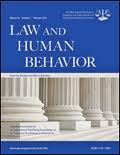 Antisocial-Impulsive psychopathic traits may serve as a risk factor for drug use while interpersonal-affective psychopathic traits may serve as a protective factor against drug use. However, gender may influence the effect of psychopathic traits on drug use. . This is the bottom line of a recently published article in Law and Human Behavior. Below is a summary of the research and findings as well as a translation of this research into practice.
Antisocial-Impulsive psychopathic traits may serve as a risk factor for drug use while interpersonal-affective psychopathic traits may serve as a protective factor against drug use. However, gender may influence the effect of psychopathic traits on drug use. . This is the bottom line of a recently published article in Law and Human Behavior. Below is a summary of the research and findings as well as a translation of this research into practice.

Featured Article | Law and Human Behavior | 2016, Vol. 40, No. 2, 159-168
Gender Differences in Psychopathy Links to Drug Use
Authors
Nicole Schulz, University of Illinois at Urbana Champaign
Brett Murphy, University of Illinois at Urbana Champaign
Edelyn Verona, University of Illinois at Urbana Champaign
Abstract
Although the relationship between psychopathic personality traits and substance use has received some attention (Hart & Hare, 1989; Smith & Newman, 1990), gender differences have not been thoroughly assessed. The current study examined whether gender modified the relationship between 2 criminally relevant constructs, (a) psychopathy and its factors and (b) drug use. A sample of 318 participants with criminal histories and recent substance use was assessed for psychopathy using the Psychopathy Checklist: Screening Version and for illicit drug use using the Structured Clinical Interview for the Diagnostic and Statistical Manual of Mental Disorders. As expected, the impulsive-antisocial traits (Factor 2) of psychopathy were positively related to a number of drug use characteristics (symptoms, age of drug initiation, extent of drug experimentation), whereas the interpersonal-affective traits (Factor 1) showed a negative relationship with drug abuse symptoms and a positive relationship with age of first use. In terms of gender differences, analyses revealed that women showed a stronger association between Factor 1 traits and later age of initiation compared to men, and that Factor 2, and the antisocial facet in particular, were more strongly related to drug abuse in women than men. These findings suggest that psychopathic traits serve as both protective (Factor 1) and risk (Factor 2) correlates of illicit drug use, and Factor 1 may be especially protective in terms of initiation of drug use among women. These conclusions add to the growing literature on potential routes to substance use and incarceration in women.
Keywords
drug use, gender, psychopathy
Summary of the Research
“Substance use is strongly related to many other forms of criminal activity within the United States. Although male substance use has received more attention, female substance use appears to be rising, especially among younger cohorts. Moreover, illicit drug use may be an especially relevant pathway to incarceration in women relative to men. For example, a sizably larger proportion of female state prison inmates are incarcerated for drug offenses, relative to males … Because incarcerated women are more likely than incarcerated men to be primary caregivers for their children, women’s substance use and incarceration is especially likely to have negative effects on families and communities, making additional research on female criminality and substance use essential” (p. 159).
“Psychopathic personality is an important criminally relevant construct that has been linked to substance use. The clinical construct of psychopathy encompasses a variety of characteristics, including serious empathy deficits, lack of remorse, impulsivity, and antisocial behavior, which can be characterized in terms of two related but distinguishable dimensions: interpersonal-affective traits and impulsive-antisocial traits . Although relationships between psychopathy and substance use have been evaluated within male samples , and some female samples , research on gender differences in relationships between psychopathic traits and illicit drug use is sparse. This study aims to address this gap in the literature by exploring gender differences in the relationship between the two psychopathy factors (and distinct traits of psychopathy) and illicit drug use, utilizing a community-dwelling sample of participants with a history of substance use and involvement with the justice system.” (p. 159)
“Mainly because of the impulsive-antisocial features of psychopathy, research has consistently shown evidence for a relationship between overall psychopathy scores and substance use behaviors, with persons with psychopathic traits more likely to exhibit serious substance use …. Research has also examined the two main factors of psychopathy. The interpersonal-affective traits (referred to as Factor 1) include deceitfulness, superficial charm, manipulativeness, deficient empathy, and lack of remorse . The impulsive-antisocial traits (referred to as Factor 2) are characterized by impulsivity, irresponsibility, weak behavioral control, and criminal versatility” (p. 160).
“An important consideration in the current psychopathy literature is whether psychopathic traits manifest similarly in women compared to men . For example, although the PCL-R is a good predictor of reoffending (recidivism) within male samples, psychopathy and recidivism are not as closely associated in women . The theoretical perspective informing our examination of gender differences in psychopathy relationships with drug use rests on two considerations. First, drug use appears to be a larger contributor to female incarceration rates , which has implications for how both drug use and psychopathy are assessed in women relative to men… Second, psychopathic traits are generally more inconsistent with cultural gender norms for women than for men” (p.160)
“There is a gap in the knowledge base concerning how gender may moderate the relationship between factors of psychopathy and substance use, especially when examining illicit drug use. In order to investigate illicit drug use reflecting the progression from initiation to addiction, we measured 4 drug use variables: retrospective reports of age of first drug initiation; range of drug experimentation; and clinically rated symptoms of both drug abuse and drug dependence, as per the Diagnostic and Statistical Manual of Mental Disorders, fourth edition, text revision (DSM–IV–TR)” (p. 161).
The Present Study
The present study utilized an existing data set from a larger project studying the relationships between drug use, gender, and violence. Participants included 318 community members with histories of drug use within the last 6 months and/or contact with the criminal justice system in the last year. “The majority of the participants had a history of legal involvement or court supervision, including 70.1% with histories of incarceration or parole/probation and 31.1% mandated to substance use treatment. Slightly fewer than half of the participants were women (n 134, 42.1%), and the participants ranged in age from 18 to 62 with a mean age of 34.75” (p. 161).
Trained staff supervised by a licensed Clinical Psychologist conducted participant interviews for approximately three hours. During that time, “a life history interview for the Psychopathy Checklist: Screening Version , modules from the Personality Disorder Interview (PDI-IV), and modules from the Structured Clinical Interview for DSM–IV–TR Axis I Disorders (SCID-I)” were administered (p. 161). Each participant received between $35 to $40 compensation for participating in the study.
Results
“The main findings of this study contribute to the literature on female drug use by showing that women demonstrate some similar relationships compared to men between psychopathic traits and various drug use variables, although we found a few notable differences. The two main gender differences revealed in our analyses are (a) the link between drug abuse and antisocial behavior facet in particular appears to be stronger in women than in men and (b) the core interpersonal and affective traits of psychopathy appear to be a modest protective factor in women, in terms of delaying their first use of illicit substances. Both of these findings lend support to the idea that psychopathic traits may be relevant to life trajectories in men and women, such as in terms of drug use” (p. 165).
“In terms of gender, both men and women showed similarly high levels of drug abuse and dependence symptoms, most likely because we recruited persons with drug histories into the study. Our results were somewhat consistent with our predictions, in that women demonstrated a marginally stronger relationship between F2 traits and drug abuse symptoms. More prominently, gender differences were strongest for relationships between substance use variables and the unique variance in the antisocial behavior facet, which to some extent can reflect lifetime incarcerations… Thus, our results indicate that the link between antisocial behavior and drug use is stronger in women than in men. This could either be a reflection of gender differences in underlying psychological characteristics of psychopathy, or it could be a reflection of gendered effects of current drug policy paradigms such as the “War on Drugs” (p. 165-166).
“Importantly, gender served as a moderator of the relationship between F1 and age of drug use initiation. Specifically, F1 traits were associated, albeit at a small effect size, with a later age of first drug use in women compared to men. This finding demonstrates that psychopathic traits in general, and its different features, and not only general antisociality (captured by F2), are important for understanding gender-differentiated manifestations of drug use, most notably in terms of early drug initiation… One explanation for the fact that women’s age of drug use initiation was more affected than men’s by F1 (and to a lesser extent F2) traits involves the idea that psychopathic traits are gender role-inconsistent for women” (p. 166).
Translating Research into Practice
“First, Psychopathy Checklist scores in women may be more heavily linked to incarceration policies of the nation’s “war on drugs.” Given that F2 scores elevate total psychopathy scores, bringing persons closer to potential cut-offs used in clinical or legal agencies, the possibility that a drug use history would confound interpretation of psychopathy scores or labels more so in women than men should be considered in making policy or legal decisions. Second, the fact that F1 traits were shown to have a stronger protective relationship with early drug use for women than men indicates that the interpersonal-affective traits are also important to consider in understanding drug use trajectories in women. Importantly, the fact that F1 traits did not interact with F2 to explain drug use in this study, whereas it has been shown to do so when it comes to BPD and self-harm, suggests that F1 traits may show complex relationships with other forms of disorder in women. This would indicate that researchers should pursue more systematic examinations of the nomological network of F1 traits and their measurement in women” (p. 167).
Other Interesting Tidbits for Researchers and Clinicians
“The current study is the first to directly study gender differences between the factors and facets of psychopathy assessed using the PCL: SV and multiple illicit drug use variables. The outcomes of this study not only add to the growing field of female drug use but can also inform future hypotheses regarding gendered pathways to drug use. For instance, drug use may be more tightly linked to history of criminal involvement in women than men” (p.167).
Join the Discussion
As always, please join the discussion below if you have thoughts or comments to add!







